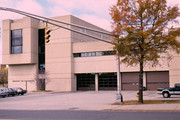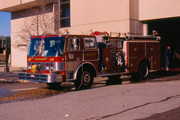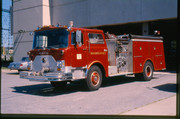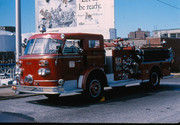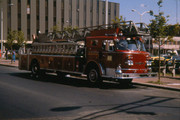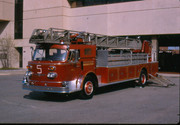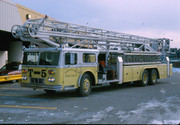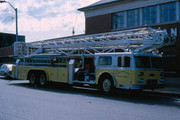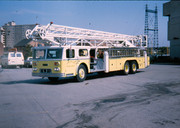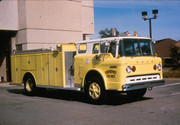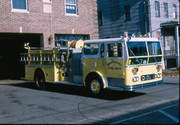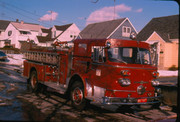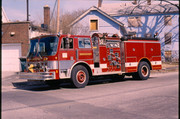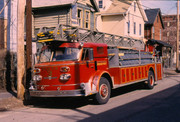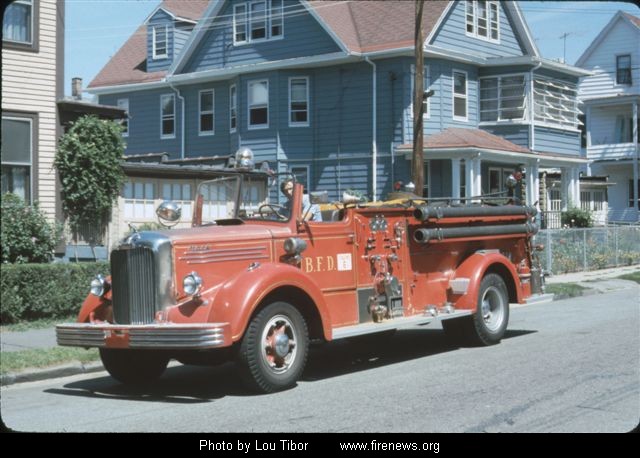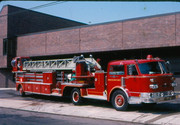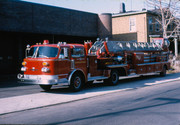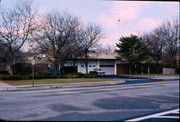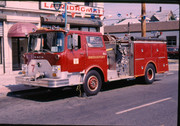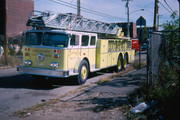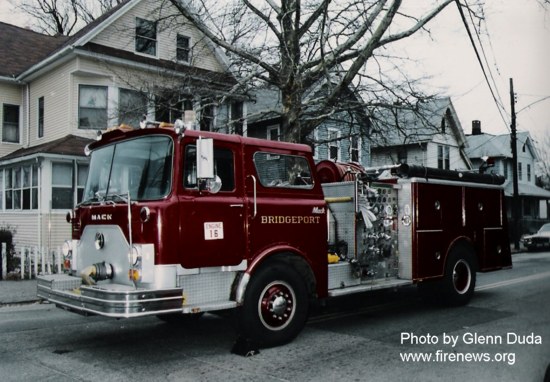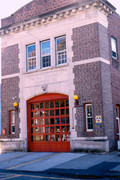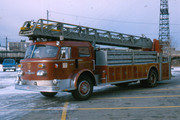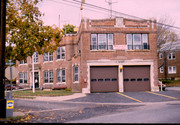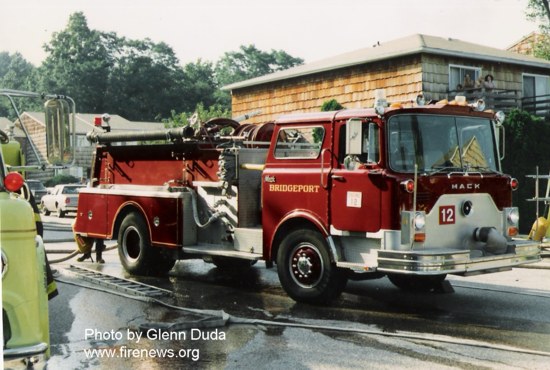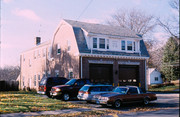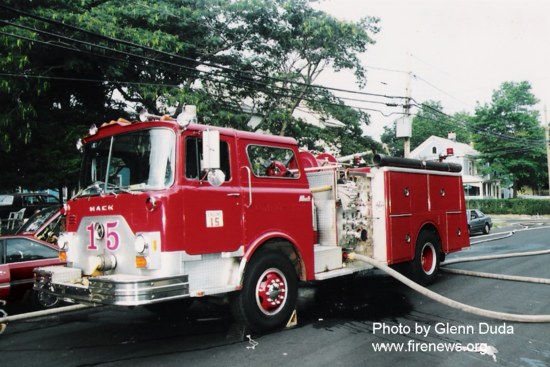At the request of Bill D. (nfd2004), I have some stories posted below written by Bill Bernhard about his memories of growing up in Bridgeport, Connecticut (located in Fairfield County, Southwestern CT) during the 1950s and 60s when his father, Howard Bernhard, was on the job on the Bridgeport Fire Department. Bill Bernhard is himself a retired Bridgeport firefighter, having followed in his fathers footsteps. Bill came on the job in 1981, a year before his father retired. These stories primarily focus on Bill B.'s memories of his childhood and his father's career, as well as a couple of stories of his time on the job. They are some great stories about the "The Greatest Generation of Firefighters". I also posted some info on the BFD in general for those who are unaware.
"My Dad, Howard Bernhard, entered the U.S. Navy near the end of World War II and after his military service, he decided to study dentistry at the University of Bridgeport, but with a wife to support and a baby coming, he needed a steady income. His neighbor on Beechwood Avenue, Bridgeport Fire Department Assistant Chief Davis, suggested that he should take the test to become a Bridgeport Firefighter. So in September, 1949, Howard Bernhard was sworn in as a Probationary Firefighter with the Bridgeport Fire Department. He was first assigned to the Norman Street Firehouse (the quarters of Engine 3 and Truck 3). In those days following World War II, the work schedule was five day tours followed by five night tours and then two days off. After several years at 3’s, he was transferred to Fire Headquarters on Middle Street.
I was born in 1951 and my memories of the BFD begin in the mid-1950s. In those days most families had only one motor vehicle, so my Mom would put me in the car each day to go and pick up or drop off my dad at the firehouse. Bridgeport Fire Headquarters was located where Middle Street and Water Street formed a triangle and came together at Congress Street and Housatonic Avenue, just to the north of the firehouse was the parking lot which was that triangle. You were lucky if you could fit a dozen or so cars in it. That is another reason why my Mom would pick up and drop off Dad. The widest part of the firehouse was its south side (“D” side), so looking at the front of Fire Headquarters, there were four bays. The bay far to the right (“A”/”D” corner) held Squad 5 and behind it was Truck 5. Squad 5 was quite busy so many times you would see only Truck 5, which was parked behind it. A 1942 closed cab Mack with a horizontal ladder rack was the apparatus that was assigned to Squad 5. It had a small water tank and pump and ran to many rubbish and vehicle fires. Truck 5 had just received their new 1955 American LaFrance 100’ tillered metal aerial ladder truck. Between the Squad/Truck bay and the Engine 5 bays was an entrance door with a polished brass door knob which opened onto the apparatus floor. The two bays to the left of the small entrance door held the two pieces of apparatus assigned to Engine 5.
In those days, Engine 5 had late 1930s open cab Mack pumpers. Many of Bridgeport’s Engine Companies were two-piece until 1992. The hose wagon would wrap the hydrant with a 2 ?” hose and proceed to the fire where they would break the hose and put a nozzle on the 2 ?” to fight the fire. The pump would go to the hydrant and hook up to it with a 4 ?” hose and attach the 2 ?” that the hose wagon dropped at the hydrant, to a discharge outlet. Some of the BFD pumpers of that era had no water tanks and certainly no pre-connects. The first water on some fires may have been Squad 5’s booster line. There was another small entrance door to the left of Engine 5’s bays which went upstairs to the Fire Prevention Bureau and the third floor Alarm Room. The final bay to the left held all of the Chiefs’ cars.
The firefighters’ schedule changed in the early 1950s, resulting in them working three day tours followed by three night tours and then three days off. There were plenty of windows to wash in those four bay doors at Headquarters as they were all glass between wooden frames. At Christmas time the firefighters would decorate all the windows in front of the firehouse in water colors creating some spectacular scenes. To the south of the firehouse stood two three-story ordinary structures that housed the Topstone Cigar warehouse. On warmer days, the Squad 5 bay door would be open and you would find firefighters leaning up against the cigar warehouse, perhaps enjoying a smoke. Across the street stood the huge Globe Theater which was perhaps as tall as a six-story building. It was torn down in about 1956, creating a parking lot for the many Downtown shoppers (pre-mall days) to park their autos. It also allowed the afternoon sun to shine on the front of the firehouse. Also across the street were a three-story and a four-story brick tenement. The three-story tenement contained the Brass Guitar on the first floor and was directly across the street from the firehouse parking lot. It was rumored that on more than one occasion a few firefighters would sneak across the street for a little liquid refreshment and have to come running when the klaxon sounded.
In those days there was very little respiratory protection provided for firefighters. The BFD had some MSA filter masks which did not protect the wearers from deadly carbon monoxide. There were only two SCBA’s on each BFD Engine Company in 1981 when I came on the department. Some BFD firefighters in the 1950s had no respiratory protection at all. I remember my Dad coming home and throwing up from smoke inhalation on more than one occasion. There was a three-story brownstone on Fairfield Avenue near West Avenue where a smoky fire occurred, causing my father to hang out a window attempting to get some clean air. A photographer from the Bridgeport Post caught a picture of him in that window. A General Alarm fire started in the First National Grocery Warehouses off of lower Main Street on May 14, 1957. It burned throughout the entire complex and caused numerous firefighters to go down with smoke inhalation including my Dad. After that tough fire, Dad decided that he would have to become a Pumper Engineer because he didn’t know how he could continue as a firefighter. I can remember him studying for hours for the upcoming test. His efforts were rewarded and in 1958, he was promoted from firefighter to Pumper Engineer. His days at the Middle Street Firehouse were now behind him."
(Up Next...Engine 16)
"My Dad, Howard Bernhard, entered the U.S. Navy near the end of World War II and after his military service, he decided to study dentistry at the University of Bridgeport, but with a wife to support and a baby coming, he needed a steady income. His neighbor on Beechwood Avenue, Bridgeport Fire Department Assistant Chief Davis, suggested that he should take the test to become a Bridgeport Firefighter. So in September, 1949, Howard Bernhard was sworn in as a Probationary Firefighter with the Bridgeport Fire Department. He was first assigned to the Norman Street Firehouse (the quarters of Engine 3 and Truck 3). In those days following World War II, the work schedule was five day tours followed by five night tours and then two days off. After several years at 3’s, he was transferred to Fire Headquarters on Middle Street.
I was born in 1951 and my memories of the BFD begin in the mid-1950s. In those days most families had only one motor vehicle, so my Mom would put me in the car each day to go and pick up or drop off my dad at the firehouse. Bridgeport Fire Headquarters was located where Middle Street and Water Street formed a triangle and came together at Congress Street and Housatonic Avenue, just to the north of the firehouse was the parking lot which was that triangle. You were lucky if you could fit a dozen or so cars in it. That is another reason why my Mom would pick up and drop off Dad. The widest part of the firehouse was its south side (“D” side), so looking at the front of Fire Headquarters, there were four bays. The bay far to the right (“A”/”D” corner) held Squad 5 and behind it was Truck 5. Squad 5 was quite busy so many times you would see only Truck 5, which was parked behind it. A 1942 closed cab Mack with a horizontal ladder rack was the apparatus that was assigned to Squad 5. It had a small water tank and pump and ran to many rubbish and vehicle fires. Truck 5 had just received their new 1955 American LaFrance 100’ tillered metal aerial ladder truck. Between the Squad/Truck bay and the Engine 5 bays was an entrance door with a polished brass door knob which opened onto the apparatus floor. The two bays to the left of the small entrance door held the two pieces of apparatus assigned to Engine 5.
In those days, Engine 5 had late 1930s open cab Mack pumpers. Many of Bridgeport’s Engine Companies were two-piece until 1992. The hose wagon would wrap the hydrant with a 2 ?” hose and proceed to the fire where they would break the hose and put a nozzle on the 2 ?” to fight the fire. The pump would go to the hydrant and hook up to it with a 4 ?” hose and attach the 2 ?” that the hose wagon dropped at the hydrant, to a discharge outlet. Some of the BFD pumpers of that era had no water tanks and certainly no pre-connects. The first water on some fires may have been Squad 5’s booster line. There was another small entrance door to the left of Engine 5’s bays which went upstairs to the Fire Prevention Bureau and the third floor Alarm Room. The final bay to the left held all of the Chiefs’ cars.
The firefighters’ schedule changed in the early 1950s, resulting in them working three day tours followed by three night tours and then three days off. There were plenty of windows to wash in those four bay doors at Headquarters as they were all glass between wooden frames. At Christmas time the firefighters would decorate all the windows in front of the firehouse in water colors creating some spectacular scenes. To the south of the firehouse stood two three-story ordinary structures that housed the Topstone Cigar warehouse. On warmer days, the Squad 5 bay door would be open and you would find firefighters leaning up against the cigar warehouse, perhaps enjoying a smoke. Across the street stood the huge Globe Theater which was perhaps as tall as a six-story building. It was torn down in about 1956, creating a parking lot for the many Downtown shoppers (pre-mall days) to park their autos. It also allowed the afternoon sun to shine on the front of the firehouse. Also across the street were a three-story and a four-story brick tenement. The three-story tenement contained the Brass Guitar on the first floor and was directly across the street from the firehouse parking lot. It was rumored that on more than one occasion a few firefighters would sneak across the street for a little liquid refreshment and have to come running when the klaxon sounded.
In those days there was very little respiratory protection provided for firefighters. The BFD had some MSA filter masks which did not protect the wearers from deadly carbon monoxide. There were only two SCBA’s on each BFD Engine Company in 1981 when I came on the department. Some BFD firefighters in the 1950s had no respiratory protection at all. I remember my Dad coming home and throwing up from smoke inhalation on more than one occasion. There was a three-story brownstone on Fairfield Avenue near West Avenue where a smoky fire occurred, causing my father to hang out a window attempting to get some clean air. A photographer from the Bridgeport Post caught a picture of him in that window. A General Alarm fire started in the First National Grocery Warehouses off of lower Main Street on May 14, 1957. It burned throughout the entire complex and caused numerous firefighters to go down with smoke inhalation including my Dad. After that tough fire, Dad decided that he would have to become a Pumper Engineer because he didn’t know how he could continue as a firefighter. I can remember him studying for hours for the upcoming test. His efforts were rewarded and in 1958, he was promoted from firefighter to Pumper Engineer. His days at the Middle Street Firehouse were now behind him."
(Up Next...Engine 16)

